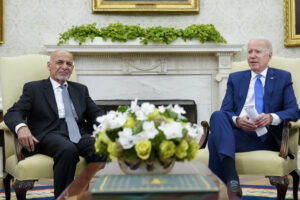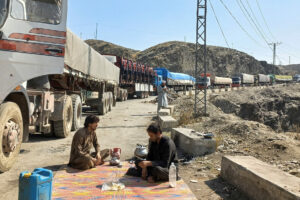Last September, Dr. Awad Mataria sounded worried. The director of health systems at the World Health Organization’s Regional Office for the Eastern Mediterranean had just returned from a mission to Kabul to meet with other United Nations agencies, INGOs, international donors, and the Taliban to finalize a plan to revive Afghanistan’s failing health systems — and things were not looking good.
The central conflict: “The Taliban has repeatedly emphasized that they would like to be engaged and to have ownership [over health programs] and to have even a stewardship, which is not something that we have been in full agreement with,” he told Devex at the time.
The Kabul mission followed an initial meeting in Doha in March 2022 to draw up a preliminary plan to guide foreign funding to address the immediate and growing health needs in Afghanistan. In the absence of an internationally recognized government, Taliban leaders are the de facto authorities after the fall of Kabul in August 2021. Getting them to agree on the plan was more than just diplomacy — they control access to the country, which is necessary for humanitarian assistance.
In the months following the Kabul mission, many more hours of diplomatic dialogue followed in Geneva, Washington, and Istanbul, aid workers who worked on the process told Devex. However, the Taliban’s December 2022 decision to ban female NGO employees from working meant that the progress made by the discussions until then was in danger of being rolled back. In the face of regressive Taliban policies, donors are increasingly cutting aid, and without the Taliban’s support, U.N. agencies run the risk of being stuck in limbo yet again.
It is in this fraught scenario that all the parties to the agreement — the Taliban, U.N. agencies, multilateral donors, and INGOs — are reviewing the draft of the plan, known as the Health Sector Transition Strategy, discussed in Kabul, Devex has learned. However, as months of interviews have revealed, the Taliban is intent on having control over the strategy, something donors are not comfortable with. Now, there are calls within the international community to engage with the Taliban in order to better serve the people of Afghanistan.
‘Will the whole system collapse?’
Before the Taliban came back into power in August 2021, the Sehatmandi project, a multidonor initiative, was the country’s main source of primary health care provided through 20,000 health care workers at 2,000 health facilities. In the aftermath of the fall of Kabul, all funding to Sehatmandi stopped abruptly. In the absence of a government, aid dollars could not be channeled for the project.
“After August [2021], there was around three months where it was very uncertain,” Fouzia Shafique, the UNICEF principal health adviser for Afghanistan, told Devex in September. There were questions: “Will the health services continue? Will the whole system collapse?”
Since then, a slew of interim measures has been put in place by the international community until a more permanent solution can be found. That includes the World Bank’s Afghanistan Reconstruction Trust Fund or ARTF, which aims to provide basic services assistance through U.N. agencies and INGOs. Additionally, funding from the World Bank’s Health Emergency Response, or HER, program, has aimed to deliver basic services and essential hospital assistance to rural areas.
“The last year has been very humanitarian-focused. And the strategy is an attempt to try to start to shift a little bit more into the development space,” a USAID official who is part of the process told Devex, requesting anonymity as they are not authorized to comment on the issue.
The international community of U.N. agencies, bilateral donors, NGOs, and multilateral banks has been keen to establish a sustainable long-term strategy.
“For the last several months [we’ve been] trying to identify what are the priorities in the health sector in Afghanistan,” Shafique said. “The needs have immensely increased, but the funding envelope remains more or less the same. There might be more funding coming in for emergency response. … But in terms of how you run the basic health services, we have not seen an increase in funding.”
Meanwhile, calls for more engagement with the Taliban are growing. In a new report published Thursday, Crisis Group emphasized the need for donors to engage with the Taliban-controlled state.
“The [UN] principles are not the binding constraints. … The problem is humanitarian and development actors are mostly constrained by donors,” Graeme Smith, Crisis Group’s senior consultant for the Asia program, told Devex.
“They’re being given a nonsensical slogan which is, ‘Help the people but don’t help the Taliban.’ It imagines a science fiction world in which you can teleport aid to all these humans across Afghanistan without regard for the people who control the country,” he said.
Common ground
There are multiple points of disagreement between the Taliban’s priorities and what the international community sees as the immediate needs on the ground.
While the meeting in Doha was largely successful in getting all the stakeholders together, its list of priorities was unwieldy. Then there was the question of why the meeting was held outside of Afghanistan in the first place.
“The discussion at that time was, [though] we had a lot of Afghan voices in the room, it was still felt that decisions on what needs to happen in Afghanistan need to be made in Afghanistan,” Shafique said.
There was an attempt to remedy the issue in the Kabul mission — which had around 10 outsiders and around 60 Afghans representing the health authorities, academic institutions, and national and international NGOs, according to Shafique. “So we had all of them in the room,” she said.
The aim of the Kabul mission was simple: the U.N.’s Transitional Engagement Framework was about to expire at the end of 2022. Before then, the agencies wanted to have a guiding document endorsed by the U.N., the IFIs, and the donors.
“We have made it clear that this is not a national health strategy. The transition strategy is saying, “What are the highest priorities? What is feasible? What can we do together?” And although it will be a U.N. and donor strategy, we want to align it as much as possible to the health authorities,” Shafique said.
“Our main engagement with them is mainly to listen to their views and to seek the best evidence upon which an immediate term transition strategy would be based,” WHO’s Mataria said. If things improve, he hoped other donors might offer up more funding.
While the Taliban leaders want to see tertiary care hospitals that would address noncommunicable diseases such as diabetes, UNICEF wants to focus on primary care, i.e., basic health needs and prevention of serious conditions.
“As is very often the case in countries like Afghanistan, the authorities will want to pull you more towards tertiary care, because that is what is visible, that is what is more attractive, politically, and otherwise,” Shafique said. “But as public health experts, we are continuously reminding them that what is important is primary health care and community health care because that is where you spend less money but get more in terms of protecting people and preventing diseases [by] treating them early on.”
Last week, Shafique and other officials from UNICEF, WHO, and the World Bank wrote in the Lancet that the health system in Afghanistan “has not collapsed,” emphasizing that “continuing donor and UN support has enabled the primary and secondary health system of Afghanistan to endure.”
“It’s very clear that donors are honestly not interested in investing in government institutions managed by the Taliban. Nor are the donors going to give the de facto authorities sign-off on the strategies and plans,” WHO’s Regional Emergency Director Rick Brennan told Devex.
The most important — and sticky — point of contention is how much of a say the Taliban get in determining how the strategy is implemented, and how much control they have over the incoming funds, Mataria said.
Donors such as the U.S. Agency for International Development believe that the process has also been informative in conveying to the Taliban how the development process works. “I would say the Taliban is learning. Sometimes they ask for things that are not possible for regulatory reasons, whether it be USAID or UNICEF, or World Bank. It is a learning curve. I think that generally, we have the same goal in mind in terms of [addressing] Afghan health,” the USAID official said.
The Taliban has already shown signs of resistance. The World Bank-supported HER project was set to begin in June 2022, but faced a setback when the Taliban Ministry of Health wanted to dictate who the local partners were, the USAID official revealed.
The Taliban Ministry of Health did not respond to Devex’s request for comment.
For U.N. agencies, and especially WHO — which leads direct engagement with the Taliban — it’s “a delicate dance,” Brennan said. “ We’re trying not to politicize the situation, but at the same time, aligning with [Taliban] priorities as far as possible. It requires constant engagement, trust-building measures, and sometimes you take two steps forward and one step back in these kinds of contexts.”
The U.N. bodies and donors have clear transparent processes including in the selection of partners for contracting, Brennan said. “So [what] if the Taliban says I don’t like that partner, and [say] that partner is corrupt. Well, they need to provide evidence for that. We can’t just act based on pressure from authorities.”
The way forward?
A representative of a donor organization who did not want to be named given the sensitive nature of the issue told Devex that “the inability of the international donors to accept Taliban’s long list of demands” might derail the implementation of the Health Sector Transition Strategy. “The U.N. agencies’ selection criteria and process for implementing NGOs without Taliban approval is also a huge hurdle,” the representative said.
The Taliban also expect financial support directly to the country’s Ministry of Public Health, he said, adding that he believes agreeing to an amicable solution with the Taliban to implement the strategy is the only way forward.
Creating enormous parallel structures funded by foreign donations is just not an option, Smith said. In early March, the strategy will be circulated to a wider group, after which U.N. agencies hope donors will fund its implementation.
But not everyone is convinced it’s the right way forward.
“We, in the international community, just don’t have the money to spend billions of dollars creating this thing that will sit alongside the Taliban-controlled state. Ultimately it has to function, collect its own revenues, and pay for its services — and we have to help that happen,” Smith said. “Because otherwise, these systems will collapse.”
source: devex
















